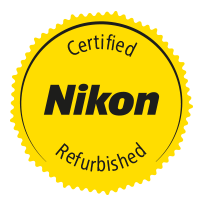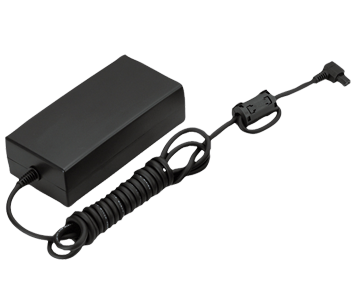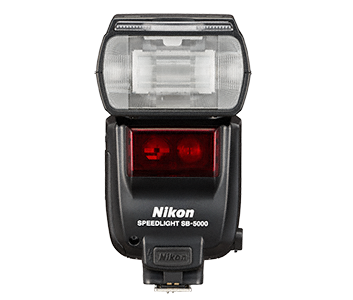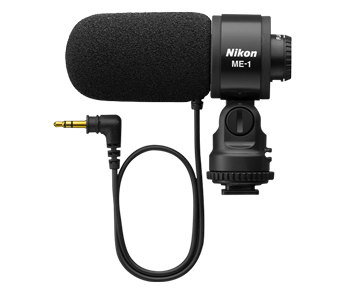











D5
Overview
Shoot beyond what the eye can see with the D5—power and precision to beat the odds.
Equipped with Nikon’s incredible next-generation 153-point AF system, the D5 keeps you on track whether you’re shooting the race or the red carpet. Coverage is exceptionally wide, and a new buffer allows up to 200 NEF (RAW) images to be captured during one high-speed burst. New image and metering sensors deliver phenomenally accurate subject recognition and image detail. The highest expanded sensitivity in Nikon’s history frees you to shoot from bright sunlight to astronomical twilight. And for moviemakers who go to extremes, D-Movie now enables high-definition 4K/UHD movies to be recorded in-camera.
Stay on top of your game with next-generation 153-point AF and 200 NEF (RAW) image buffer
Own the game with Nikon’s phenomenal new AF system. With an incredible 153 focus points and 99 cross-type sensors, the D5 offers exceptionally wide coverage. Whether you’re shooting the race or the red carpet, almost every situation is covered. Small subjects moving at high speed can be tracked with a new level of precision. Subjects at the edge of the frame are easily detected, and vertical shooting is vastly improved. AF sensitivity down to -4 EV (ISO 100, 20 °C/68 °F) enables superior low-light performance and all AF modes have been improved. The system is configurable in 153-point, 72-point and 25-point coverage settings in Continuous AF mode. All 153 focus points are compatible with AF NIKKOR lenses with an open aperture of f/5.6 or faster, and 15 central focus points work with an effective aperture of f/8. The camera’s high-performance buffer allows up to 200 NEF (RAW) or large JPEG images to be captured during one high-speed burst: enough to cover an entire 100 m sprint final without taking your finger off the shutter-release button.
Beat the odds with a winning combination of power and precision
The phenomenal performance of the D5 is all you need to capture images that defy the odds. Thanks to a new AF ASIC unit, maximum computing power is allocated to AF at all times. No matter how fast the action, the camera does not compromise. Shoot at up to 12 fps with AE/AF tracking, or at up to 14 fps with mirror up. AF tracking and viewfinder visibility are vastly improved when shooting sports, or any scene in which subjects tend to change direction suddenly. Faster sequential shutter and mirror mechanisms significantly reduce viewfinder blackout during high-speed bursts. For ultimate precision, pair the D5 with a professional NIKKOR lens equipped with SPORT VR mode, such as the AF-S NIKKOR 600mm f/4E or the AF-S NIKKOR 500mm f/4E. SPORT VR mode also delivers a stable viewfinder image when tracking high-speed movement. Combine the D5 with one of these lenses and you’ll capture fast-moving, unpredictable subjects with unprecedented smoothness.
Move ahead of the pack with new metering and image sensors
The sheer imaging power of the D5 is a liberating experience. The all-new 20.8 MP FX-format CMOS image sensor and 180K-pixel RGB metering sensor deliver phenomenally accurate subject recognition and image detail. Even if you’re shooting fast sports indoors, this camera will get you the shot. And not just any shot: tonal gradations are richer and more accurate. The D5 also boasts a new 8.0 cm (3.2 in.), 2360k-dot LCD monitor, which offers touch operation in review mode. With a level of responsiveness comparable to smartphones, this high-resolution screen means you can easily check and select key images on the spot. Shoot in Live View and you can use touch operation to change the focus point, or acquire preset Spot White Balance data, based on the selected area within the frame. For even greater control, Picture Control 2.0 makes it easy to define parameters whether you’re shooting stills or video. Ease post-production with the Flat pre-setting for maximum dynamic range; fine-adjust detail with Clarity.
From bright sunlight to astronomical twilight: shoot beyond what the eye can see
The D5 blows the possibilities for low-light shooting wide open. With a standard ISO range of 100 to 102400, and the highest expanded sensitivity in Nikon’s history, the envelope is yours to push. Thanks to the camera’s new EXPEED 5 image processing engine, image quality is unprecedentedly high across the standard ISO range. This exceptionally clean performance is made possible by a signal processing system optimised for the new sensor's 25% higher pixel count. Fine noise is dramatically reduced and even cropped images shot at high ISOs retain their quality. In an incredible feat of engineering, the ISO range can now be extended to ISO 3280000 equivalent, at the Hi 5 setting. Designed for specialist use, such as surveillance or security applications, these astonishingly high ISO counts enable colour images to be captured without a flash in astronomical twilight, which is equivalent to an amazingly low 0.001 lux.
Go to extremes: 4K high-definition D-Movies
As the first Nikon DSLR to record high-definition 4K/UHD movies in-camera, the D5 hugely exceeds the moviemaking flexibility of the D4S. 4K movies (3840x2160 pixels) can be recorded at 30p/25p/24p in dot-by-dot native pixel crop, which ensures the highest image quality. When shooting Full HD (1080p) video, you can record at frame rates up to 50p/60p in multiple sensor crop formats, including native Full HD pixel crop. When filming in M mode, sensitivity for all video resolutions and crop modes can be set from ISO 100 all the way up to Hi 5. Auto ISO allows ISO 200 up to Hi 5, and lets you configure the maximum ISO settings you want to work with. The camera offers clean HDMI out: even 4K movies can be recorded to the in-camera memory card or output uncompressed to HDMI with 8-bit 4:2:2 YCbCr. HDMI output is available for all movie resolutions during remote shooting.
Turbocharge your workflow: high-speed image capture and 4x faster data transfer
Faster, sharper, and easier to handle, everything about the D5 is geared towards a smoother experience. Engineered to incorporate feedback from agency photographers who spend all day shooting, this camera reduces the stress factors that come with the demands of professional photography. Ergonomically, improvements include buttons with more defined ridges and curves, which enable more intuitive control, especially when shooting through the viewfinder. New double XQD card slots easily handle the D5’s incredible capacity to shoot up to 200 NEF (RAW) images in one burst, and ensure the buffer is instantly cleared for the next burst. A new USB 3.0 port enables high-speed transfer of large amounts of data, and wireless and Ethernet connection is now 4x faster. Beyond the camera body, Nikon’s Creative Lighting System continues to go from strength to strength with the new SB-5000. This new Speedlight utilises radio communication and improves the performance of Nikon flash systems under challenging conditions.
Tech Specs
-
-
Type
-
Single-lens reflex digital camera
-
-
-
Lens mount
-
Nikon F mount (with AF coupling and AF contacts)
-
-
-
Image sensor
-
FX, CMOS, 35.9 mm x 23.9 mm
-
-
-
Total pixels
-
21.33 million
-
-
-
Dust-reduction system
-
Image sensor cleaning, Image Dust Off reference data (Capture NX-D software required)
-
-
-
Effective pixels
-
20.8 million
-
-
-
Image size (pixels)
-
FX (36 x 24) image area, (L) 5568 x 3712, (M) 4176 x 2784, (S)2784 x 1856, 1.2 x (30 x 20) image area, (L) 4640 x 3088, (M) 3472 x 2312, (S) 2320 x 1544, DX (24 x 16) image area, (L) 3648 x 2432, (M) 2736 x 1824, (S) 1824 x 1216, 5 : 4 (30 x 24) image area, (L) 4640 x 3712, (M) 3472 x 2784, (S) 2320 x 1856, FX-format photographs taken during movie recording at a frame size of 1920 x 1080 or 1280 x 720, (L) 5568 x 3128, (M) 4176 x 2344, (S) 2784 x 1560, DX-format photographs taken during movie recording at a frame size of 1920 x 1080 or 1280 x 720, (L) 3648 x 2048, (M) 2736 x 1536, (S) 1824 x 1024, Photographs taken during movie recording at a frame size of 3840 x 2160: 3840 x 2160 Photographs taken during movie recording at a frame size of 1920 x 1080 crop: 1920 x 1080
-
-
-
Storage file formats
-
NEF (RAW): 12 or 14 bit (lossless compressed, compressed, or uncompressed); large, medium, and small available (medium and small images are recorded at a bit depth of 12 bits using lossless compression), TIFF (RGB), JPEG: JPEG-Baseline compliant with fine (approx. 1 : 4), normal (approx. 1 : 8), or basic (approx. 1 : 16) compression; optimal quality compression available, NEF (RAW)+JPEG: Single photograph recorded in both NEF (RAW) and JPEG formats
-
-
-
Picture Control System
-
Standard, Neutral, Vivid, Monochrome, Portrait, Landscape, Flat, selected Picture Control can be modified; storage for custom Picture Controls
-
-
-
Storage media
-
XQD, CompactFlash (CF) (Type I, UDMA compliant)
-
-
-
Dual card slot
-
2 XQD cards or 2 CompactFlash (CF) cards, Slot 2 can be used for overflow or backup storage or for separate storage of copies created using NEF+JPEG; pictures can be copied between cards.
-
-
-
File system
-
DCF 2.0, Exif 2.3, PictBridge
-
-
-
Viewfinder
-
Eye-level pentaprism single-lens reflex viewfinder
-
-
-
Frame coverage
-
FX (36 x 24): Approx. 100% horizontal and 100% vertical, 1.2 x (30 x 20): Approx. 97% horizontal and 97% vertical, DX (24 x 16): Approx. 97% horizontal and 97% vertical, 5:4 (30 x 24): Approx. 97% horizontal and 100% vertical
-
-
-
Magnification
-
Approx. 0.72 x (50 mm f/1.4 lens at infinity, -1.0 m-1)
-
-
-
Eyepoint
-
17 mm (-1.0 m-1; from center surface of viewfinder eyepiece lens)
-
-
-
Diopter adjustment
-
-3 to +1 m-1
-
-
-
Focusing screen
-
Type B BriteView Clear Matte Mark IX screen with AF area brackets (framing grid can be displayed)
-
-
-
Depth-of-field preview
-
Yes, Pressing Pv button stops lens aperture down to value selected by user (A and M modes) or by camera (P and S modes)
-
-
-
Lens aperture
-
Instant return, electronically controlled
-
-
-
Compatible lenses
-
Compatible with AF NIKKOR lenses, including type G, E, and D lenses (some restrictions apply to PC lenses) and DX lenses (using DX 24 x 16 1.5 x image area), AI-P NIKKOR lenses, and non-CPU AI lenses (exposure modes A and M only). IX NIKKOR lenses, lenses for the F3AF, and non-AI lenses can not be used. The electronic rangefinder can be used with lenses that have a maximum aperture of f/5.6 or faster (the electronic rangefinder supports 15 focus points with lenses that have a maximum aperture of f/8 or faster, of which 9 points are available for selection).
-
-
-
Shutter type
-
Electronically-controlled vertical-travel focal-plane mechanical shutter; electronic front-curtain shutter available in mirror up release mode
-
-
-
Shutter speed
-
1/8000 to 30 s, in steps of 1/3, 1/2, or 1 EV, bulb, time, X250
-
-
-
Flash sync speed
-
X = 1/250 s; synchronizes with shutter at 1/250 s or slower
-
-
-
Release mode
-
S (single frame), CL (continuous low speed), CH (continuous high speed), Q (quiet shutter-release), Self-timer, MUP (mirror up)
-
-
-
Frame advance rate
-
12 fps, up to 10 fps (CL); 10–12 fps, or 14 fps with mirror up (CH); or 3 fps (quiet continuous mode)
-
-
-
Self-timer
-
2 s, 5 s, 10 s, 20 s; 1 to 9 exposures at intervals of 0.5, 1, 2, or 3 s
-
-
-
Metering method
-
Matrix: 3D color matrix metering III (type G, E, and D lenses); color matrix metering III (other CPU lenses); color matrix metering available with non-CPU lenses if user provides lens data Center-weighted: Weight of 75% given to 12 mm circle in center of frame. Diameter of circle can be changed to 8, 15, or 20 mm, or weighting can be based on average of entire frame (non-CPU lenses use 12-mm circle) Spot: Meters 4 mm circle (about 1.5% of frame) centered on selected focus point (on center focus point when non-CPU lens is used) Highlight-weighted: Available with type G, E, and D lenses
-
-
-
Metering range (ISO 100, f/1.4 lens, 20 °C/68 °F)
-
Matrix or center-weighted metering: -3 to +20 EV Spot metering: 2 to 20 EV Highlight-weighted metering: 0 to 20 EV
-
-
-
Exposure meter coupling
-
CPU, AI
-
-
-
Mode
-
Programmed auto with flexible program (P); shutter-priority auto (S); aperture-priority auto (A); manual (M)
-
-
-
Exposure compensation
-
-5 to + 5 EV, in steps of 1/3, 1/2, or 1EV
-
-
-
Exposure lock
-
Luminosity locked at detected value
-
-
-
ISO sensitivity
-
ISO 100 to 102400, in steps of 1/3, 1/2, or 1 EV, can also be set to approx. 0.3, 0.5, 0.7, or 1 EV (ISO 50 equivalent) below ISO 100 or to approx. 0.3, 0.5, 0.7, 1, 2, 3, 4, or 5 EV (ISO 3280000 equivalent) above ISO 102400; auto ISO sensitivity control available
-
-
-
Active D-Lighting
-
Can be selected from Auto, Extra high +2/+1, High, Normal, Low, or Off
-
-
-
Autofocus
-
Multi-CAM 20K autofocus sensor module with TTL phase detection, fine-tuning, and 153 focus points (including 99 cross-type sensors and 15 sensors that support f/8), of which 55 (35 cross-type sensors and 9 f/8 sensors) are available for selection
-
-
-
Detection range
-
-4 to +20 EV (ISO 100, 20 °C/68 °F)
-
-
-
Lens servo
-
Single-servo AF (AF-S), Continuous-servo AF (AF-C), predictive focus tracking automatically activated according to subject status, Manual focus (M): Electronic rangefinder can be used
-
-
-
Focus points
-
153 focus points, of which 55 or 15 are available for selection
-
-
-
AF-area mode
-
Single-point AF, 25-, 72-, or 153- point dynamic-area AF, 3D-tracking, group-area AF, auto-area AF
-
-
-
Focus lock
-
Focus can be locked by pressing shutter-release button halfway (single-servo AF) or by pressing the center of the sub-selector
-
-
-
Flash control
-
TTL: i-TTL flash control using RGB sensor with approximately 180K (180,000) pixels; i-TTL balanced fill-flash for digital SLR is used with matrix, center-weighted, and highlight-weighted metering, standard i-TTL fill-flash for digital SLR with spot metering
-
-
-
Flash modes
-
Front-curtain sync, slow sync, rear-curtain sync, red-eye reduction, red-eye reduction with slow sync, slow rear-curtain sync, off, Auto FP High-Speed Sync supported
-
-
-
Flash compensation
-
-3 to +1 EV in steps of 1/3, 1/2 or 1 EV
-
-
-
Flash-ready indicator
-
Lights when optional flash unit is fully charged; flashes after flash is fired at full output
-
-
-
Accessory shoe
-
ISO 518 hot-shoe with sync and data contacts and safety lock
-
-
-
Nikon Creative Lighting System
-
Supported
-
-
-
Sync terminal
-
ISO 519 sync terminal with locking thread
-
-
-
White balance
-
Auto (3 types), incandescent, fluorescent (7 types), direct sunlight, flash, cloudy, shade, preset manual (up to 6 values can be stored, spot white balance measurement available during live view), choose color temperature (2500 K to 10000 K), all with fine-tuning.
-
-
-
White balance bracketing
-
Exposure, Flash, White balance, ADL
-
-
-
Live View - Modes
-
Movie live view, Photo live view with available silent mode
-
-
-
Live view - lens servo
-
Autofocus (AF): Single-servo AF (AF-S); full-time-servo AF (AF-F) Manual focus (M)
-
-
-
Live view - AF-area mode
-
Face-priority AF, Wide-area AF, Normal-area AF, Subject-tracking AF
-
-
-
Live view - autofocus
-
Contrast-detect AF anywhere in frame (camera selects focus point automatically when face-priority AF or subject-tracking AF is selected)
-
-
-
Movie - metering
-
TTL exposure metering using main image sensor
-
-
-
Movie - metering method
-
Matrix, center-weighted, or highlight-weighted
-
-
-
Movie - frame size (pixels) and frame rate
-
3840 x 2160 (4K UHD): 30p (progressive), 25p, 24p; 1920 x 1080: 60p, 50p, 30p, 25p, 24p; 1920 x 1080 crop: 60p, 50p, 30p, 25p, 24p; 1280 x 720: 60p, 50p; Actual frame rates for 60p, 50p, 30p, 25p, and 24p are 59.94, 50, 29.97, 25, and 23.976 fps respectively; high quality available at all frame sizes, normal quality available at all sizes except 3840 x 2160
-
-
-
Movie - file format
-
MOV
-
-
-
Movie - video compression
-
H.264/MPEG-4 Advanced Video Coding
-
-
-
Movie - audio recording format
-
Linear PCM
-
-
-
Movie - audio recording device
-
Built-in stereo or external microphone; sensitivity adjustable
-
-
-
Movie - ISO sensitivity
-
Exposure modes P, S, and A: Auto ISO sensitivity control (ISO 100 to Hi 5) with selectable upper limit Exposure mode M: Auto ISO sensitivity control (ISO 100 to Hi 5) available with selectable upper limit; manual selection (ISO 100 to 102400 in steps of 1/3, 1/2, or 1 EV) with additional options available equivalent to approximately 0.3, 0.5, 0.7, 1, 2, 3, 4, or 5 EV (ISO 3280000 equivalent) above ISO 102400
-
-
-
Monitor
-
8 cm (3.2–in.) diagonal, TFT touch-sensitive LCD with 170 ° viewing angle, approximately 100% frame coverage, and manual monitor brightness control, approx. 2359k-dot (XGA)
-
-
-
Playback
-
Full-frame and thumbnail (4, 9, or 72 images) playback with playback zoom, movie playback, photo and/or movie slide shows, histogram display, highlights, photo information, location data display, auto image rotation, picture rating, voice memo input and playback, and IPTC information embedding and display
-
-
-
USB
-
SuperSpeed USB (USB 3.0 Micro-B connector), connection to built-in USB port is recommended
-
-
-
HDMI output
-
Type C HDMI connector
-
-
-
Audio input
-
Stereo mini-pin jack (3.5 mm diameter; plug-in power supported)
-
-
-
Audio output
-
Stereo mini-pin jack (3.5 mm diameter)
-
-
-
Accessory terminal(s)
-
Ten-pin remote terminal: can be used to connect optional remote control, WR-R10 (requires WR-A10 adapter) or WR-1 wireless remote controller, GP-1/GP-1A GPS unit, or GPS device compliant with NMEA0183 version 2.01 or 3.01 (requires optional MC-35 GPS adapter cord and cable with D-sub 9-pin connector); Ethernet connector: RJ-45 connector Standards: IEEE 802.3ab (1000BASE-T)/IEEE 802.3u (100BASE-TX)/IEEE 802.3 (10BASE-T) Data rates: 10/100/1000 Mbps with auto detect (maximum logical data rates according to IEEE standard; actual rates may differ) Port: 1000BASE-T/100BASE-TX/10BASE-T (AUTO-MDIX); Peripheral connector: For WT-6, WT-5
-
-
-
Supported languages
-
Arabic, Bengali, Bulgarian, Chinese (Simplified and Traditional), Czech, Danish, Dutch, English, Finnish, French, German, Greek, Hindi, Hungarian, Indonesian, Italian, Japanese, Korean, Marathi, Norwegian, Persian, Polish, Portuguese (Portugal and Brazil), Romanian, Russian, Serbian, Spanish, Swedish, Tamil, Telugu, Thai, Turkish, Ukrainian, Vietnamese
-
-
-
Battery
-
One rechargeable Li-ion EN-EL18a battery
-
-
-
AC adapter
-
EH-6b AC adapter; requires EP-6 power connector (available separately)
-
-
-
Tripod socket
-
1/4–in. (ISO 1222)
-
-
-
Dimensions (W x H x D)
-
Approx. 160 x 158.5 x 92 mm (6.3 x 6.3 x 3.7 in.)
-
-
-
Weight
-
Approx. 1405 g (3 lb. 1.6 oz.), with battery and two XQD memory cards but without body cap and accessory shoe cover; approx. 1235 g/2 lb. 11.6 oz. (camera body only); approx. 1415 g (3 lb. 1.9 oz.), with battery and two CompactFlash memory cards but without body cap and accessory shoe cover; approx. 1240 g/2 lb. 11.8 oz. (camera body only)
-
-
-
Operating environment - temperature
-
0 °C to 40 °C (+32 °F to 104 °F)
-
-
-
Supplied accessories
-
Body Cap BF-1B, Accessory Shoe Cover BS-3, Rechargeable Li-ion Battery EN-EL18a with terminal cover, Battery Charger MH-26a with power cable and two contact protectors (shape of power cable depends on country of sale), USB Cable Clip, HDMI Cable Clip, USB Cable UC-E22, Strap AN-DC15
-
-
Unless otherwise stated, all measurements are performed in conformity with Camera and Imaging Products Association (CIPA) standards or guidelines.
-
All figures are for a camera with a fully-charged battery.
-
Nikon reserves the right to change the appearance and specifications of the hardware and software described in these specifications at any time and without prior notice. Nikon will not be held liable for damages that may result from any mistakes that these specifications may contain.
Accessories
Included Accessories
Optional Accessories
What does it take to create iconic pictures? Matthias Hangst, sports photography
What does it really take to create iconic pictures? Award-winning sports photographer, Matthias Hangst, shares his thoughts. "The D5 really pushes things to a new level. Better ISO performance gives me the chance to shoot with faster shutter speed and freeze any sort of action. Once, when the sun was coming in really low, we were shooting a player in a white jersey in order to see how the D5 performs with low contrast, back lit subjects. We got around 20 or 30 frames in a row and the AF tracking performance was really impressive." Matthias Hangst, award-winning sports photographer.
Listen to the pros: Ole Jørgen Liodden, Nature & wildlife photography
What does it take to really stand out as a nature & wildlife photographer? Listen to professional nature photographer, Ole Jørgen Liodden, as he shares his thoughts. "Once we saw two grizzle bears - young adults - fighting or playing in the water. It was very dark and I was shooting at ISO 102400, but the image quality was still impressive. It rained almost every day on the Alaska shoot and the camera was usually wet, but it still worked perfectly. That’s extremely important to me: It means I have a tool that works in all kinds of conditions. The fact that the D5’s autofocus can detect subjects even at -4 EV is a great update." Ole Jørgen Liodden, Norwegian nature and wildlife photographer.
Hear it from the pros: Bill Frakes, photojournalism
"Emotional motion. The visual switch has no off position for me. I make images whenever the moment presents itself, and that's pretty often." - Bill Frakes. On the Nikon D5: "This is an amazing imaging machine. It has unbelievably accurate autofocus systems, high ISO beyond anything I could previously have imagined possible, and unmatched ergonomics. I’m so excited to have a 4K file from a Nikon. 4K is critical to me because I want to show every detail in a file format that will remain viable and contemporary far into the future. I’ve dedicated my life to storytelling and I can absolutely depend on Nikon to see me through." Bill Frakes, photojournalism, sports and filmmaking.
Chasing speed: Mirco Lazzari, Motor sports
“The photo of the rider just as he turned the corner and came right up close to me – you have to shoot 12 frames in 1 second to capture a shot like this! The way the D5’s autofocus tracked and acquired the image, and the clear visibility of the viewfinder are two big steps forward which makes this photo possible.” Mirco Lazzari, pro motor sports photographer.
Finding beauty: Dixie Dixon, Fashion photography
"I absolutely loved working with the D5. Skin tones are extremely important in my work and I feel like this camera really excels in that area. Its continuous shooting speed and autofocus, you can also capture what you couldn’t before: those split second facial expressions are usually the best shots. I also found the new touch screen very helpful in letting me quickly zoom in check sharpness, hair/makeup and many other details." Dixie Dixon, fashion, beauty and lifestyle photographer.


































 Contact Us
Contact Us